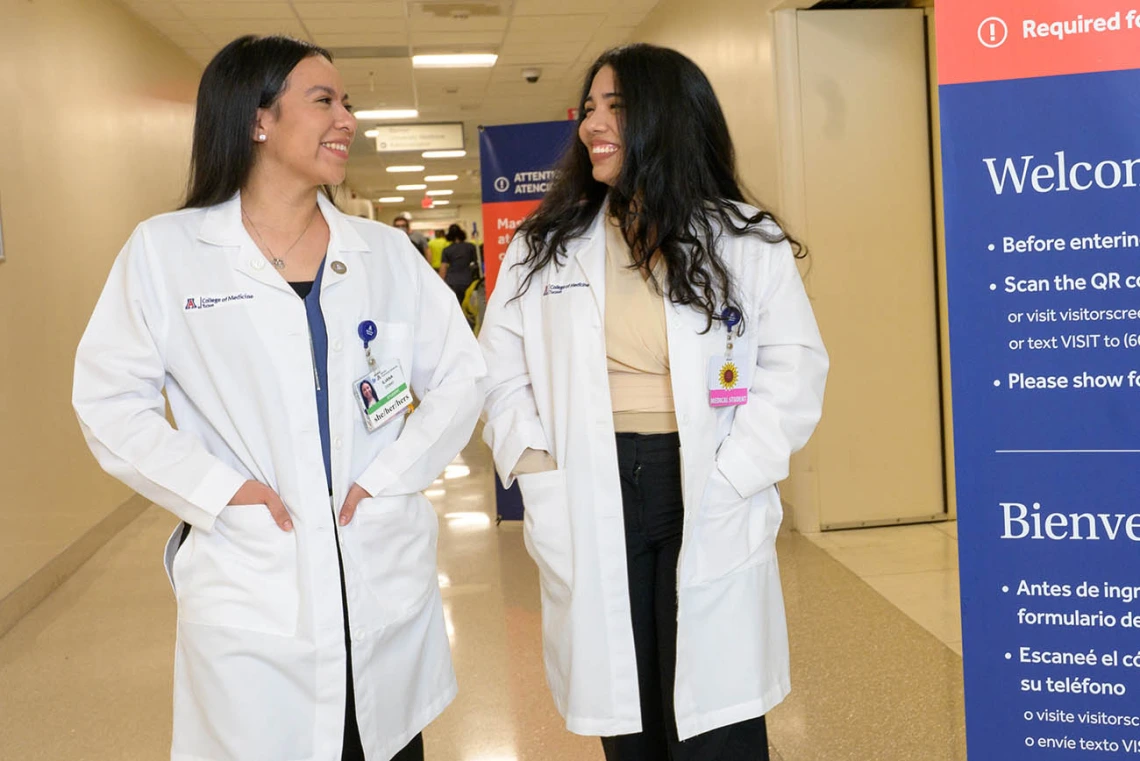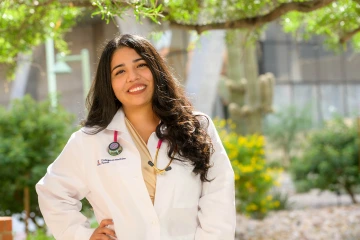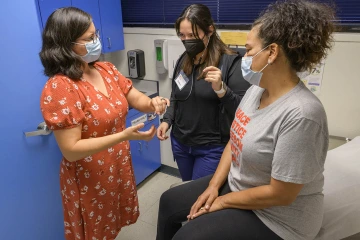Students, Community Benefit from Medical Interpreter Course
A service-learning course provides bilingual Spanish-speaking students clinical experience as medical interpreters and a pathway to a career in medicine.

(From left) Aspiring physicians Iliana Cosio and Isabellyana Dominguez met as undergraduate students in FACES Conversantes, and their friendship continues in medical school.
Speaking two languages came easily to Phoenix native Iliana Cosio. Her parents were bilingual, but her grandparents only spoke Spanish. That meant Cosio spoke Spanish during the day while her grandparents babysat and reverted to English when her parents returned from work.

Iliana Cosio, a second-year student in the UArizona College of Medicine – Tucson, always wanted to practice medicine, and her experience in the FACES Conversantes class reaffirmed her goals.
As Cosio grew older, she occasionally accompanied her grandparents to doctor appointments. That was where she first realized how language can be a significant barrier to equitable health care. Many times, Cosio helped her grandparents understand what the doctor was saying and vice versa.
“I would notice that it was just quiet in the room. There really was no communication between them,” Cosio recalled, referring to her grandparents and the physicians. “If there was conversation, it was all medical and never personal.”
Cosio’s experience is not unique to many bilingual children who play the role of interpreter for their non-English speaking family members. But the skill of interpreting eventually became one that shaped Cosio’s career.
While Cosio was studying physiology as an undergraduate, she joined a University of Arizona Health Sciences service-learning course called Fostering and Achieving Culture Equity and Sensitivity in the Health Professions (FACES) Conversantes. The course provides bilingual Spanish-speaking students with training and opportunities to volunteer as medical interpreters in health care facilities in southern Arizona.
“My experience with Conversantes convinced me to apply to the University of Arizona College of Medicine – Tucson,” said Cosio, who is now a second-year student at the UArizona College of Medicine – Tucson. "It was so humbling getting involved with the Tucson community at such an early time."
Speaking the same language
According to Census data, the U.S. Hispanic population topped 62 million in 2020, a 23% increase from the previous decade. In Arizona, where the state’s population grew 12% between 2010 and 2020, nearly 1 in 3 people are of Hispanic or Latino decent. Additionally, 27% of Arizonans report speaking a language other than English at home.

Isabellyana Dominguez, a second-year student in the College of Medicine – Tucson, listed FACES Conversantes at the top of her experiences in her medical school application.
The data reflect a growing population of residents who are from medically underrepresented populations. In the health care setting, that translates to an increasing need for bilingual providers who can reduce language barriers.
Prior research found that patients with limited English proficiency experience longer hospital stays and are at increased risk of medical errors and misdiagnosis, among other disparities. A 2014 study published in the Journal of Health Care for the Poor and Underserved concluded that the use of professional interpreters reduces such disparities, improves clinical outcomes and results in greater patient satisfaction.
The mission of the Health Sciences Office of Equity, Diversity and Inclusion, which oversees FACES Conservantstes, is to increase the diversity of the health sciences workforce. Studies have shown that patients have better experiences when treated by health care providers who share their racial or ethnic background. In Arizona, 6.7% of physicians are Hispanic/Latino, compared with 32.3% of the population.
“I think this is a small piece of a bigger puzzle.”
Alejandra Zapien Hidalgo, MD, MPH
Isabellyana Dominguez, a second-year student at the College of Medicine – Tucson, says her participation in FACES Conversantes introduced her to the realities of these disparities.
“To this day, I think Conversantes is one of the things that has impacted me the most because I didn't know how I could make a difference,” Dominguez said. “Conversantes introduced me to underserved communities and how I could, as a Spanish speaker, make a difference if I were to go into the medical field.”
Diversifying the workforce
FACES Conversantes was started in 2004 to fill a need for Hispanic or Latino aspiring physicians to get clinical hours to boost their medical school applications.
“What we were seeing was that these students either didn’t have the time to do the hours or they didn’t know how important those hours were for their applications,” said Alejandra Zapien Hidalgo, MD, MPH, a FACES Conversantes instructor and professor in the Department of Family and Community Medicine at the College of Medicine – Tucson.

Alejandra Zapien Hidalgo, MD, MPH, says it is crucial that students help with interpretating at free clinics such as Clinica Amistad, where a majority of the volunteer physcians do not speak Spanish.
In the course, students learn basics of medical care, including taking vital signs and understanding common medical complaints, such as chest pains. They practice medical interpretation techniques through a combination of lectures, role-playing scenarios, case studies and presentations. Students then volunteer two to three hours per week as Spanish interpreters in local health care facilities such as Clínica Amistad, the Mel and Enid Zuckerman College of Public Health’s Mobile Health Unit and clinics run by the College of Medicine – Tucson Commitment to Underserved People program.
“One of the goals of the course is to increase the number of underrepresented minority students that go into the health care workforce,” Dr. Zapién said. “That is why it is important to train the students in the classroom and provide them the opportunity to go into community to apply what they have learned.”
In recent years, Dr. Zapién says the program has broadened its reach beyond those looking to become physicians. She says it is more open to attracting bilingual students thinking of pursuing nursing, public health or other health professions.
“I think this is a small piece of a bigger puzzle, which is health disparities,” Dr. Zapién said. “We are training students that already have the language and the cultural knowledge to serve our Hispanic/Latinx community. It is important to show our students, early on their career, the positive impact they can have in our community.”
Making personal connections
Cosio never wavered in her desire to pursue medicine, but taking FACES Conversantes erased any doubts about that ambition. She recalled the impact her work was having on patients visiting the clinic where she was volunteering.

Dr. Zapién (left) provides instruction to volunteers who support the physicians at Clinica Amistad.
“When I would walk into the room and introduce myself in Spanish, it’s like they would light up,” Cosio said. “It changes everything for the patient.”
She remembers one patient particularly well.
“I was giving them their glucose readings for the day, and they said to me, ‘Oh my goodness, I wish there were more people like you in the medical profession.’ Those relationships are how I finalized my decision of wanting to go into medicine.”
Additionally, Cosio and Dominguez are examples of how FACES Conversantes fosters meaningful relationships among the students sharing a pathway to medicine.
“We had that first acquaintance in Conversantes, and we’ve been really good friends from then on,” Dominguez said. “It’s awesome to be where we are now and look back at everything we’ve done to get here.”
“The nice thing about the program is knowing that you’re not the only person who’s pursuing the same dream,” Cosio added. “There are others who may not have your exact same background, but they have that similar foundation for why they want to pursue medicine.”
Our Experts
Contact
Blair Willis
Health Sciences Office of Communications
520-626-2101
bmw23@arizona.edu

